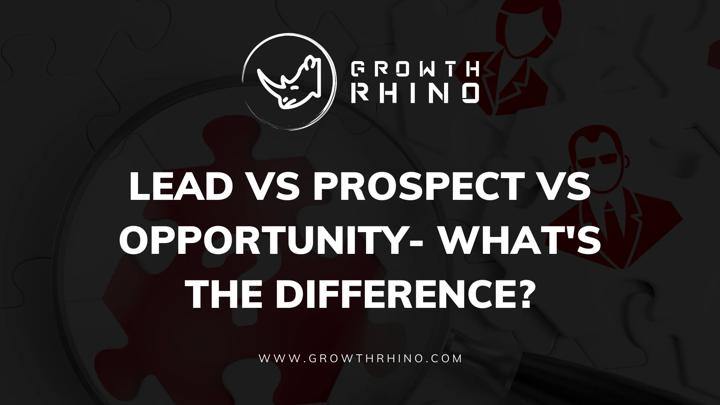
Lead generation is part of marketing. It is the process of piquing the minds of potential customers and getting their attention. It influences their decision-making so that they would be interested in making a purchase of a product or service.
When studying lead generation, it is crucial to determine lead vs prospect vs opportunity. These three may seem similar, but they are actually different from one another.
What Is Lead?
A lead is essentially any person who has shown interest in the products or services of a company, but may not yet be qualified to make a transaction. It is the contact information. In certain cases, it is also the demographic information of potential customers.

A lead may come from a variety of activities or sources, such as the Internet, personal referrals, advertisements, events, and phone calls.
How to Achieve More Leads?
If you want better lead opportunity prospect to make your business grow further, you need to achieve more leads. To do this, you need to do the following:
1) Direct Engagement:
You can directly contact your prospective customers via email, social media, or phone. You can even set up a meeting once you establish that they may be an ideal fit for the business.
2) Advertise and Retarget:
You can use targeted pay-per-click advertising to promote your business to prospective customers. This will boost your search engine presence by serving ads for searches that you know are highly relevant to the business.
3) Ask Current Customers for Referrals:
This is among the oldest strategies for lead generation. Simply ask your customers to refer your product or service to other people. You can offer incentives, such as discounts, to further encourage them to do this.
4) Write Guest Blogs:
You can take advantage of search engine optimization and content marketing by writing guest blogs. It can generate referral traffic from relevant sources and even allow you to form new connections in the industry.
What Are the Types of Leads?
In general, there are three types of leads:
1. Information Qualified Leads (IQLs):
These are individuals who have been to your website and have given you their contact details in exchange for access to vital data. For example, they have subscribed to a newsletter to be able to download an e-book. However, they are not yet ready to turn into prospect leads. They require more nurturing in order to be qualified.
2. Marketing Qualified Leads (MQLs):
These are leads that have a high chance of becoming customers. They are generated from blog posts, ads, and other activities for lead generation marketing. However, even though they are interested in your business, they are still not sure if they want to push through.
3. Sales Qualified Leads (SQLs):
These are leads that have shown their interest in making a purchase. For example, they have signed up for a free trial. They have a high chance of converting into customers. Hence, you should directly follow up with them.
How Many Leads Do You Need?
It is understandable that you want to know more about leads and prospects as much as possible. However, you really cannot determine the exact number of leads that you need if you do not have goals that are specific and clear, as well as knowledge of the performance history of your marketing and sales team.
You need to consider these factors and understand them. Whatever the goal of your business is, it has to be stated clearly right from the beginning. Also, you have to determine your conversion rates at every stage of the funnel. You have to determine how many leads to opportunities you are able to convert, how many opportunities you close, and how big or small is the average size of your deals.
What Is Prospect?
Prospects refer to people who have a high probability of turning into leads or opportunities. They tend to need more information for them to be ready for a sales conversation.

What Is Opportunity?
Opportunities are prospects who have been deemed to have potential to convert into customers. They have shown interest in making a business transaction and are usually ready for a meeting or sales call.
Lead vs Opportunity vs Prospect – Key Differences
In lead generation, it is crucial to define lead vs opportunity and prospects vs lead properly.
Leads are potential customers who may or may not fit within the target market. They are not qualified to be prospects because not much is known about them. Prospects provide more information.
Opportunities are potential customers who have shown interest in the product and/or service. They are the most valuable of the three types of potential customers since they are the ones who are most likely to make a purchase.
Prospects are potential customers who meet the target criteria of the market. However, they have not shown any interest in making a purchase yet.
Lead vs Prospect:
The main difference between lead and prospect is that prospects provide more information than leads and that they have not shown any interest in making any transaction yet.

Leads, on the other hand, have shown interest in making a transaction but are not yet qualified to take a step further towards conversion. They are at the top of the funnel.
Lead vs Opportunity:
How about opportunities vs leads? Prospects become opportunities once they begin to consider changing the service or product, as well as start to think about getting your offered solution.
Leads are blurry and vague. They have to be processed and identified just to highlight prospective prospects that may qualify and are fit to turn into opportunities.
Prospect vs Opportunity:
You now know about prospect lead opportunity. So, what is the difference between prospects and opportunities?
Well, prospects are leads who have not yet qualified as potential buyers. Opportunities are qualified prospects who have a huge possibility of turning into clients. They should have a pain point, which can be resolved by using your products or services. They should also be interested in making a purchase.
How Do You Turn Prospects Into Leads?
In order to turn prospects into leads, you can do the following:

- Engage your prospects every time, no matter where they are in their customer journey.
- Create a solid strategy for marketing before you begin executing.
- See to it that you have proper content strategies before you start to attract prospective customers.
How Do You Turn Prospects Into Opportunities?
It is important to turn prospects into opportunities because they will eventually turn into customers. In order for you to do this, you can do the following:
- Update your prospecting list.
- Change your attitude towards sales for the better.
- Improve your communication skills, specifically with regard to making phone calls.
- Improve your close rate.
Is It Important to Qualify Sales Emails?
Yes, it is. Qualification helps you maximize your efforts. By qualifying your sales emails, you can also know more about your status. You can find out if the opportunity is a good fit or not. Thus, you can either stay or walk away.
Conclusion
Lead generation is vital for business growth. You need it to have new sales opportunities and customers. This is why you need to understand leads, prospects, and opportunities better.
